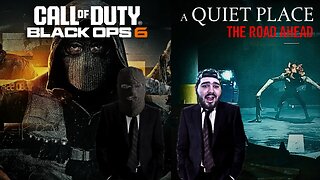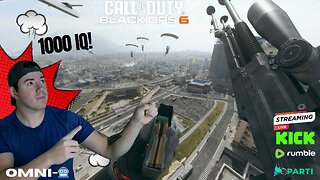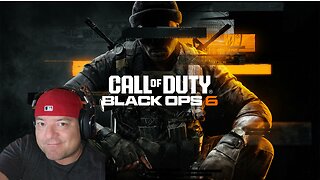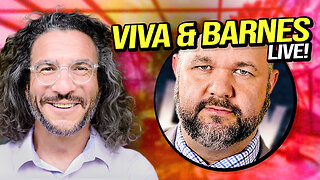Premium Only Content

What The Bleep Do We Know, 2004 - THE OBSERVER EFFECT, Double Slit Experiment
And here we are, the granddaddy of all quantum weirdness, the infamous double slit experiment. To understand this experiment, we first need to see how particles, or little balls of matter, act. If we randomly shoot a small object, say a marble, at the screen, we see a pattern on the back wall where they went through the slit and hit. Now if we add a second slit, we would expect to see a second band duplicated to the right. Now let's look at waves. The waves hit the slit and radiate out, striking the back wall with the most intensity directly in line with the slit. The line of brightness on the back screen shows that intensity. This is similar to the line the marbles make. But when we add the second slit, something different happens. If the top of one wave meets the bottom of another wave, they cancel each other out. So now there is an interference pattern on the back wall. Places where the two tops meet are the highest intensity, the bright lines, and where they cancel, there is nothing. So when we throw things, that is, matter, through two slits, we get this, two bands of hits. And with waves, we get an interference pattern of many bands. Good so far. Now let's go quantum. An electron is a tiny, tiny bit of matter, like a tiny marble. Let's fire a stream through one slit. It behaves just like the marble, a single band. So if we shoot these tiny bits through two slits, we should get, like the marbles, two bands. What? An interference pattern! We fired electrons, tiny bits of matter, through. But we get a pattern like waves, not like little marbles. How? How could pieces of matter create an interference pattern like a wave? It doesn't make sense. But physicists are clever. They thought, maybe those little balls are bouncing off each other and creating that pattern. So they decide to shoot electrons through one at a time. There is no way they could interfere with each other. But after an hour of this, the same interference pattern is seen to emerge. The conclusion is inescapable. The single electron leaves as a particle, becomes a wave of potentials, goes through both slits, and interferes with itself to hit the wall like a particle. But mathematically, it's even stranger. It goes through both slits, and it goes through neither. And it goes through just one, and it goes through just the other. All of these possibilities are in superposition with each other. But physicists were completely baffled by this. So they decided to peek and see which slit it actually goes through. They put a measuring device by one slit to see which one it went through and let it fly. But the quantum world is far more mysterious than they could have imagined. When they observed, the electron went back to behaving like a little marble. It produced a pattern of two bands, not an interference pattern of many. The very act of measuring, or observing, which slit it went through meant it only went through one, not both. The electron decided to act differently, as though it was aware it was being watched. And it was here that physicists stepped forever into the strange never-world of quantum events. What is matter? Marbles or waves? And waves of what? And what does an observer have to do with any of this? The observer collapsed the wave function simply by observing. Quantum physics calculates only possibilities. But if we accept this, then the question immediately comes, who, what chooses among these possibilities to bring the actual event of experience? So we directly, immediately see that consciousness must be involved. The observer cannot be ignored. We know what an observer does from a point of view of quantum physics, but we don't know who or what the observer actually is. Doesn't mean we haven't tried to find an answer. We've looked. We've gone inside of your head. We've gone into every orifice you have to find something called an observer. And there's nobody home. There's nobody in the brain. There's nobody in the cortical regions of the brain. There's nobody in the subcortical regions or the limbic regions of the brain. There's nobody there called an observer. And yet we all have this experience of being something called an observer, observing the world out there. Is this the observer and which is so intricate to understanding the wacky, weird world of quantum particles and how they react? Is this then the observer? In my modeling, the observer is the spirit inside the four layered bio-body suit. And so it's like the ghost in the machine. It is the consciousness that's driving the vehicle. And it is observing the surround. The four layers of the bio-body suit have all kinds of sensory systems to pick up signatures from the surround. Every civilization is a reflection of its knowledge. Civilization is based upon knowledge, the prevailing paradigm. Now you look at the globe today, our rainbow colored globe, you see arbitrary divisions among nations, among peoples. These are completely random, completely arbitrary based upon who owned what at what period of time in history. But if somebody in the future looks back upon our globe of today, they're going to say, this is a fragmented world. Based upon a fragmented world.
-
 15:21
15:21
Degenerate Jay
13 hours ago $0.03 earnedThe Mystery Of Silent Hill 2's Strange Photos Has Finally Been Solved
384 -
 9:47
9:47
Cooking with Gruel
16 hours agoMastering Potato Gratin
4284 -
 8:34
8:34
GBGunsRumble
11 hours agoGBGuns Range Report 24NOV24
812 -
 2:04:09
2:04:09
Nerdrotic
11 hours ago $74.72 earnedNew Peruvian Megalithic Site Discovery w/ Michael Collins | Forbidden Frontier #083
149K15 -
 6:40:53
6:40:53
Fresh and Fit
12 hours agoMyron TRIGGERED Rubi Rose, And Debating Cry Baby Blax On X Spaces!
155K113 -
 4:54:16
4:54:16
TheSaf3Hav3n
10 hours ago $22.81 earnedCALL OF DUTY: BLACK OPS 6 | A QUIET PLACE: THE ROAD AHEAD | #RumbleTakeOver
53.5K1 -
 4:05:35
4:05:35
TheNateVibez
10 hours agoOmni-🤖 - First Rumble Stream.🫡 - VETERAN
56K3 -
 2:59:26
2:59:26
Tundra Gaming Live
15 hours ago $5.09 earnedThe Worlds Okayest War Thunder Stream//FORMER F-16 MAINTAINER//77th FS//#rumblefam
33.9K1 -
 2:32:19
2:32:19
DemolitionDx
10 hours agoSunday night COD with friends.
112K6 -
 2:10:14
2:10:14
vivafrei
20 hours agoEp. 237: More Trump Cabinet Picks! MAHA or Slap in the Face? Canada on Fire! Go Woke Go Broke & MORE
239K299